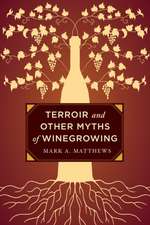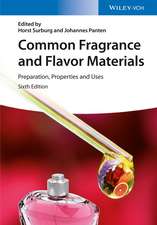Meat Biotechnology
Editat de Fidel Toldráen Limba Engleză Paperback – 28 oct 2010
The main goal of this book is to provide the reader with the recent developments in biotechnology and their applications in the meat processing chain. To achieve this goal, the book is divided into four parts. The first part deals with the use of modern biotechnology applied to farm animals. The second part focuses on the recent biotechnological developments in starter cultures for better meat fermentation. The third part discusses current approaches to improve the quality and nutritional properties of meats. The final part presents the latest advances in protection against foodborne pathogens, and other recent trends in the field. Written by distinguished international contributors, this book brings together the advances in such varied and different biotechnological topics.
| Toate formatele și edițiile | Preț | Express |
|---|---|---|
| Paperback (1) | 938.83 lei 6-8 săpt. | |
| Springer – 28 oct 2010 | 938.83 lei 6-8 săpt. | |
| Hardback (1) | 944.88 lei 6-8 săpt. | |
| Springer – 15 sep 2008 | 944.88 lei 6-8 săpt. |
Preț: 938.83 lei
Preț vechi: 1144.91 lei
-18% Nou
Puncte Express: 1408
Preț estimativ în valută:
179.73€ • 184.84$ • 149.10£
179.73€ • 184.84$ • 149.10£
Carte tipărită la comandă
Livrare economică 19 februarie-05 martie
Preluare comenzi: 021 569.72.76
Specificații
ISBN-13: 9781441927217
ISBN-10: 1441927212
Pagini: 516
Ilustrații: XIV, 500 p.
Dimensiuni: 155 x 235 x 27 mm
Greutate: 0.72 kg
Ediția:Softcover reprint of hardcover 1st ed. 2008
Editura: Springer
Colecția Springer
Locul publicării:New York, NY, United States
ISBN-10: 1441927212
Pagini: 516
Ilustrații: XIV, 500 p.
Dimensiuni: 155 x 235 x 27 mm
Greutate: 0.72 kg
Ediția:Softcover reprint of hardcover 1st ed. 2008
Editura: Springer
Colecția Springer
Locul publicării:New York, NY, United States
Public țintă
ResearchDescriere
Meat and meat products constitute one of the most important foods in western societies. However, the area of meat biotechnology is not as comprehensively covered as other areas of food biotechnology. Missing from this area are the recent developments for better sensory and nutritional quality as well as improved safety.
The main goal of this book is to provide the reader with the recent developments in biotechnology and their applications in the meat processing chain. To achieve this goal, the book is divided into four parts. The first part deals with the use of modern biotechnology applied to farm animals. The second part focuses on the recent biotechnological developments in starter cultures for better meat fermentation. The third part discusses current approaches to improve the quality and nutritional properties of meats. The final part presents the latest advances in protection against foodborne pathogens, and other recent trends in the field. Written by distinguished international contributors, this book brings together the advances in such varied and different biotechnological topics.
The main goal of this book is to provide the reader with the recent developments in biotechnology and their applications in the meat processing chain. To achieve this goal, the book is divided into four parts. The first part deals with the use of modern biotechnology applied to farm animals. The second part focuses on the recent biotechnological developments in starter cultures for better meat fermentation. The third part discusses current approaches to improve the quality and nutritional properties of meats. The final part presents the latest advances in protection against foodborne pathogens, and other recent trends in the field. Written by distinguished international contributors, this book brings together the advances in such varied and different biotechnological topics.
Cuprins
Animal Biotechnology for the Enhancement of Meat Quality.- Transgenic Farm Animals.- Genetic Control of Meat Quality Traits.- DNA-Based Traceability of Meat.- Biotechnology of Starter Cultures for Meat Fermentation.- Molecular Methods for Identification of Microorganisms in Traditional Meat Products.- Characteristics and Applications of Microbial Starters in Meat Fermentations.- Genetics of Lactic Acid Bacteria.- Genetics of Yeasts.- Characteristics and Applications of Molds.- Biotechnology for Better Quality and Nutritional Properties of Meat Products.- Biotechnology of Flavor Generation in Fermented Meats.- Latest Developments in Probiotics.- Bioactive Compounds in Meat.- Biotechnology for Safer Meat and Meat Products.- Biocontrol of Pathogens in the Meat Chain.- At-Line Methods for Controlling Microbial Growth and Spoilage in Meat Processing Abattoirs.- The Detection of Genetically Modified Organisms: An Overview.- Biosensors for Detecting Pathogenic Bacteria in the Meat Industry.- Immunology-Based Techniques for the Detection of Veterinary Drug Residues in Foods.- Antimicrobial Activity of Bacteriocins and Their Applications.- Bioprotective Cultures.- Smart Packaging Technologies and Their Application in Conventional Meat Packaging Systems.- Meat Safety and Regulatory Aspects in the European Union.
Notă biografică
Dr. Fidel Toldá is a Professor in the Department of Food Science at the Instituto de Agroquímica y Technología de Alimentos in Valencia, Spain.
Textul de pe ultima copertă
Meat and meat products constitute some of the most important foods in western societies. However, the area of meat biotechnology is not as comprehensively covered as other areas of food biotechnology. Missing from this area are the recent developments for better sensory and nutritional quality as well as improved safety.
The main goal of this book is to provide the reader with the recent developments in biotechnology and their applications in the meat processing chain. To achieve this goal, the book is divided into four parts. The first part deals with the use of modern biotechnology applied to farm animals. The second part focuses on the recent biotechnological developments in starter cultures for better meat fermentation. The third part discusses current approaches to improve the quality and nutritional properties of meats. The final part presents the latest advances in protection against foodborne pathogens, and other recent trends in the field. Written by distinguished international contributors, this book brings together the advances in such varied and different biotechnological topics.
The main goal of this book is to provide the reader with the recent developments in biotechnology and their applications in the meat processing chain. To achieve this goal, the book is divided into four parts. The first part deals with the use of modern biotechnology applied to farm animals. The second part focuses on the recent biotechnological developments in starter cultures for better meat fermentation. The third part discusses current approaches to improve the quality and nutritional properties of meats. The final part presents the latest advances in protection against foodborne pathogens, and other recent trends in the field. Written by distinguished international contributors, this book brings together the advances in such varied and different biotechnological topics.
Caracteristici
A reference book in biotechnology and its application to meat processing
Presents recent biotechnological developments that currently are being applied in meat processing plants
Includes supplementary material: sn.pub/extras
Presents recent biotechnological developments that currently are being applied in meat processing plants
Includes supplementary material: sn.pub/extras








